This photo essay is by Bill Newby, Seattle City Light's Director of Operations for the Skagit River dam project. Edited and curated by David Wilma.
Seattle City Light -- Bill Newby Working on the Skagit, 1935-1996 -- A Slideshow Photo Essay
- By Dave Wilma
- Posted 2/03/2001
- HistoryLink.org Essay 7040
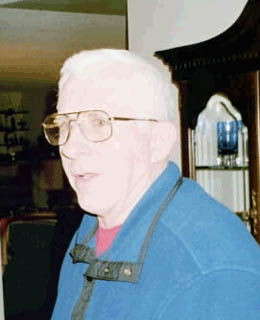
Bill Newby worked for Seattle City Light on the Skagit Project from 1954 until 1996 when he retired as Director of Operations for the whole project. Bill's grandfather established a homestead near Marblemount in 1886 and Bill was born in the City Light community of Newhalem. In 2001, he recalls some of the things he saw and did on the Skagit.
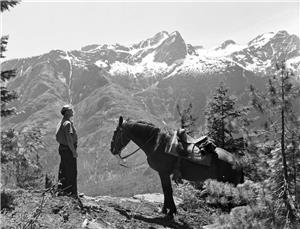
"That's Dad. They farmed. As soon as Dad was old enough to get out, he started packing, making a living packing for the Forest Service, and then helped build the railroad and helped pack City Light into the Skagit. When they were doing their Diamond exploration work [beginning in 1919], Dad was packing them in there too, pack people and supplies back in there. His title says Farrier, horse shoer, then he labored for the Skagit with a team of horses whenever it was needed, moving supplies, groceries, sled in the wintertime, get rid of the garbage, and that type of work."

"That's my brother Jim and that's our dog. That's Lead. [In 1940, City Light produced a color movie about the Skagit Project] And he's in the movie too. That was part of the horse-pack trip to make the movie. When I found the movie that they were throwing away and nobody really gave a rat's ass. But I did. I made a copy."
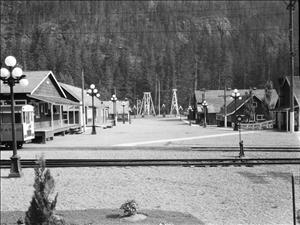
"That's Main Street in Newhalem [in 1949]. As you look down the street to the left, is one of the scooter cars. They were the electric cars that ran around Newhalem and then went on up to Diablo. You have the main warehouse, the large building on the left. It's a long long building, you don't see but very little of it."

The next building you see is the Commissary, which is still there today. In the distance there is the cookhouse, Gorge Inn. The towers are the bridge going to little Newhalem Creek or Generator 20. The other building is the Big Hall, now it's called Currier Hall. Then you come up the street, you've got the office which was there for quite some time. Now that's a museum. It just barely shows the front of it, that's the hotel for people coming in and out. You see two sets of railroad, there was a wye [where one track becomes two] in here. Where you see a few flowers growing was a grape arbor and they threw horsehoes and that kind of thing. The highway today is right where the railroad's at." "I wanted to duplicate [those streetlights] when I was there, but there was some resistance. There are some of them around now, in the towns."

[Newlalem 1949] "Of course the railroad is going right through the middle of it. The closest to you, there's a long building there. That was the lineman's warehouse. Off the left is Silk Stocking Row [the fanciest houses]. The school house in the middle."

"That shows the lineman's warehouse, the long building. This shows the middle of Newhalem. You see several wyes, the railroad. You can see the houses, there is row after row, pretty much an open area now. Silk Stocking Row sort of bands along the river. Silk Stocking Row, anybody can live there now. But at that time they were ... set up for the higher echelon. There are five rows of houses that are all gone. The third row actually shows two long garages that are still there. there's a little house at the end of those garages. I lived in there, first, second grade, in the '40s."
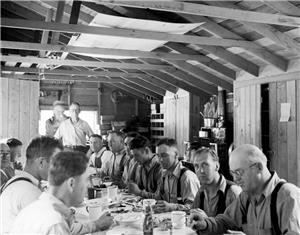
"They ate like kings. City Light fed as good as you can feed anybody. Ninety cents a day. two-bits a meal and 15 cents for your room. And that stayed forever. Ninety cents a day."
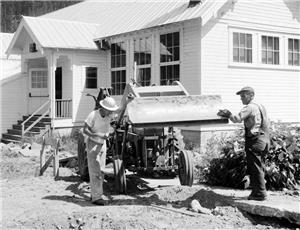
"I started out laboring and that covers a multitude of sin. The first day I was there, I was "coyoting" a hole from the river to Gorge cookhouse for a drain pipe -- digging a hole with a shovel. From there, whatever, cutting grass, or loading trucks, shoveling gravel, like I say, whatever had to be done, that what you done."

"I guess I did about everything there was to do. Then, as a maintenance laborer -- and that put you a little closer to the heavy equipment. I worked as an oiler, or drive the crane, or work with the cat operators, whatever was being done."
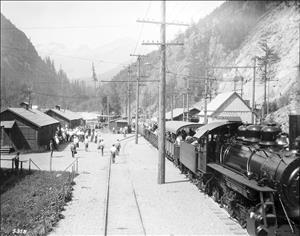
"This is the lokie on one of the two trips it made to Diablo. If you follow it down, there's sort of a pink and white building. That's the base of the incline, that's the communications building right now. They had the lokie up there, but they gave it up for electric because of the grade. The next building down is the waiting station for the base of the incline. If you jump across the street, where you see the people, that was the cookhouse. It's seven miles [from Newhalem]."
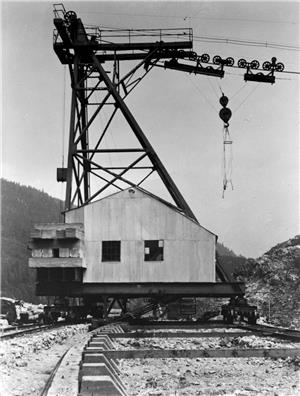
"Lumber came from Newhalem, on barge on Diablo Lake and then picked off Diablo Lake and set onto Ross Lake with the hi-line which was left over from building the dam. That's how you got material to Ross until they built a little jeep road. Now it goes from the power house to the top of the dam. But for years and years and years, that was not there. Everything went by the hi-line. Over the top of Ross into Ross Lake."
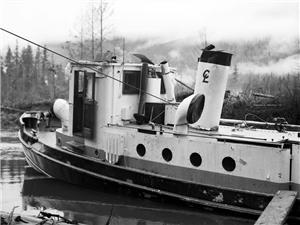
"I moved lots of boats back and forth from Diablo to Ross. I was running the hi-line at that time and reached down to Diablo Lake, grab a boat and pick it up over the dam and set it into Ross. They were tug boats. Eighteen ton was the weight of the boats. Worked as a deck hand on the boats on Diablo Lake."
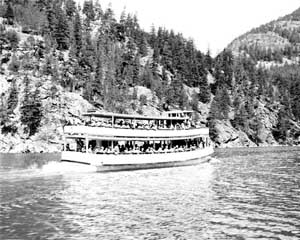
"They brought in the Alice [Ross], then they brought in a military landing -- I think it was LCM [Landing Craft Mechanized] and then built a top on it for tourists. The boats moved in there and I just moved them back and forth as they were needed. That one LCM is still laying down there at the bottom, not too far from Diablo Dam. When they brought that in, they brought it through Canada, down the logging road, into the basin of Ross. The logging road came down to Lightning Creek. Before they got to Lightning Creek, they dumped it off the truck. Managed to get it put back together. It just sunk and it's still down there. They had a boat sink up there on Ross and it's still down there. That was way back early early days. They were manufactured right up there on the lake."

"I worked on the logging crew, went up on the floating camp. That was on Ross. We had a logging camp, everything was floating on Ross, the steel crew used it, it had a floating dry dock on it, to work on boats. A lot of work was being done on the dam, on the gates at that time."

"I drove a tour bus. That was pretty interesting. One time during the day, you would get caught having a group of people with no tour guide either going or coming. That was during the time of the World's Fair. Five tours a day. We were flying, moving people, and you would get caught somewhere during the day being tour guide as well as bus driver for half your run. You always had some prank you could pull on them about the color of the water, tell them that they had taken all the kilowatts out of the water. It was a good time."

"Seven major avalanches between Newhalem and Diablo. I got buried. I lost a piece of equipment in an avalanche. I run like you-know-what. We did it as good as we could do it and still work under the conditions. The watchman sounded the alarm. Forget it, I'm gone. I watched my cat get buried as I turned around and hit the road."
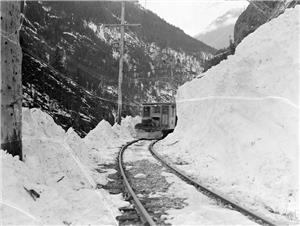
"We'd be clearing the road of an avalanche and another avalanche would come down on top of you. During the railroad, they had the same, but they had a little shovel, massive hand digging. They had a small shovel front that sat on the front of a railroad car that they would use and throw it over the side and just keep inching it forward with the railroad. Now that's all been turned over to the state highways."

"This is way back in '29. This is one of those cars that was gas-operated. It had its own engine. They had them around for quite some time. Actually, they had them right to the end."

"This is Jack Hunt. His wife was the nurse. He was the dispatcher, kept track of where the trains were. That stayed into effect well up into the late '50s, even after the railroad went out [in 1954]. They sort of hung onto it as sort of a hub of where the trucks were going. Trying to control traffic going to Diable because that was a lot of one-way type of travel."
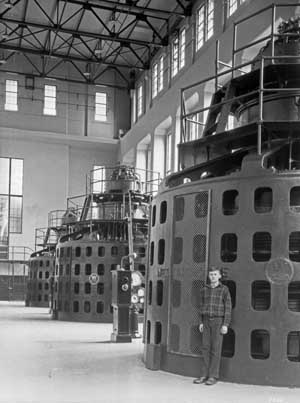
"You don't see that today because they're all in what they call air housings. What you're seeing there now is the way I remember them. When they put the air housings, that controlled the heat, because there is a tremendous amount of heat. If you were to walk into an air housing today, it would be probably 120. Hotter than hell in there."
Licensing: This essay is licensed under a Creative Commons license that encourages reproduction with attribution. Credit should be given to both HistoryLink.org and to the author, and sources must be included with any reproduction. Click the icon for more info. Please note that this Creative Commons license applies to text only, and not to images. For more information regarding individual photos or images, please contact the source noted in the image credit.

